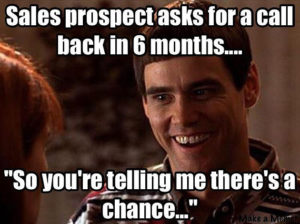Not every sales prospect is created equal. As a salesperson, there will be many occasions when you pitch to an uninterested prospect. Trying to sell your product or service to dead sales leads wastes your time and energy.
5 ways to know if you have dead sales leads on your hands
Here are some of the warning signs that your leads are unqualified and some suggestions on how to qualify them.
Find your ideal sales prospect using Crunchbase Pro
They already have a similar product
It’s important to do research beforehand to see if your lead already using a product similar to yours. If the company or business already shows a long-standing loyalty to an existing vendor, chances are slim that it will switch to your product or service.
Rebuttal: Not all hope is lost, though. Even if a lead has a product similar to yours, there is a chance they’re unhappy with the current service. Your product may have better features that could improve the lead’s existing experience. You can also stand out by offering a more competitive price – this may revive any dead sales leads. Hot tip: Use G2 Stack data directly in Crunchbase to see which companies are using a competitor.
Your product is out of their price range
Even if potential customers are interested in your product, there may not be a budget for it. This means your the leads are unqualified. For example, you are selling a particular software for $50,000. While this is the standard cost for a mid-sized company, offering this price to a small start-up business isn’t going to be fruitful for you.
Even if the company you’re pitching to has a steady stream of revenue, it doesn’t necessarily mean it has a large budget for your product or service.
Rebuttal: In the case where your product or service is out of your lead’s budget, review your current pricing to see if there are any areas where you can trim down costs. You could take out a specific feature or service to create a price that your lead could then afford.
When you pitch to the wrong person
You’ve passed the initial stage of cold calling and get your 20-minute sales pitch ready to present. But, when it’s time to close the deal, you find out that your audience doesn’t really have any real purchasing power or authority. Although there is a possibility that you’ve convinced them to talk about your product or service with an upper executive, the chances are highly unlikely. Your pitch ends up being simply a courtesy listen.
Before arriving at your in-person sales pitch, confirm that you are not talking with an intern or entry-level employee. Ensure someone in the room will have some sort of authority or authorization to move the process forward. If not, this is a definite sign that your lead will not fully be interested or invested in what you’re selling and you’re dealing with dead sales leads.
Rebuttal: If you find out that your appointment is with a middleman, ask to reschedule with a senior manager, director or C-level employee. If all senior-level employees are unavailable, don’t neglect your time with a gatekeeper. He or she could refer you to a higher-level representative in the near future.
Your prospect has no clear deadline
You and your lead need to have a discussion about deadlines during the initial outreach period. The lead should clearly state when he or she wants to decide on a vendor and when a product or service will be fully implemented – whether that’s during a cold call or in an initial email. If there are no clear dates or deadlines, and urgency seems to lack, it’s recommended that you focus on warmer leads instead.
You can gauge a lead’s interest by how quickly he or she schedules your initial phone call or meeting. If a prospect seems excited to meet with you and tries to see you as soon as possible, this is a positive sign that he or she wants to hear about your product or service.
Rebuttal: Set clear dates throughout your conversation with your lead. For example, ask your lead when he or she wants to fully implement your product. Instead of saying you will follow up with a lead or give them a period of time to think about your product, set specific dates and deadlines. You can also offer a limited-time discount to provide an extra incentive.
Your lead is resisting next steps
Does your lead seem to have a list of problems or concerns with your product or service? Do you continue to repeat the same solutions? Is your lead ignoring recommendations for taking the next step or have excuses for not following through with future discussions?
If you answered yes to any of these questions, you most likely spent your time making a pitch to dead sales leads. Someone who is consistently ignoring solutions and accommodations you’re making is not looking to buy what you’re selling. Also, if responses are severely delayed during the follow-up period, take it as a sign that your prospect doesn’t want to move forward.
Rebuttal: Before completely giving up on your lead, try a few different closing methods. If you’ve only communicated through email thus far, try making a phone call. You can even stop by in person at a time that is convenient with your lead. If all your efforts seem to fall short, try speaking to a new point of contact.
How Crunchbase can help you identify new sales leads
Focusing on dead sales leads wastes your time and energy as a salesperson and causes you to miss out on potential profits elsewhere. Crunchbase Pro helps you generate targeted sales leads that are better suited for your product or service. We offer customizable filters to locate prospects who are within your target field and location.
Our product also offers valuable information on a company’s existing clients, funding, investments, staff changes, and IPOs. Each of these trigger events provides deeper information on whether a business actually needs and will be interested in what you’re selling.












